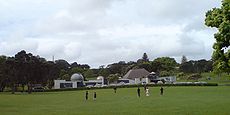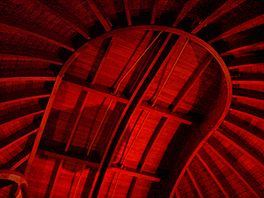
Stardome Observatory
Encyclopedia

One Tree Hill, New Zealand
One Tree Hill is a 182 metre volcanic peak located in Auckland, New Zealand. It is an important memorial place for both Māori and other New Zealanders...
in New Zealand
New Zealand
New Zealand is an island country in the south-western Pacific Ocean comprising two main landmasses and numerous smaller islands. The country is situated some east of Australia across the Tasman Sea, and roughly south of the Pacific island nations of New Caledonia, Fiji, and Tonga...
's largest city, Auckland
Auckland
The Auckland metropolitan area , in the North Island of New Zealand, is the largest and most populous urban area in the country with residents, percent of the country's population. Auckland also has the largest Polynesian population of any city in the world...
.
Founded in 1967, the observatory is administered by the Auckland Observatory and Planetarium Trust Board. The Trust Board was created by the Auckland Astronomical Society (AAS) in 1956. The Stardome Observatory is also home to the AAS.
Functions
| Asteroid Asteroid Asteroids are a class of small Solar System bodies in orbit around the Sun. They have also been called planetoids, especially the larger ones... s discovered: 1 |
|
|---|---|
| 19620 Auckland 19620 Auckland 19620 Auckland is a main-belt asteroid discovered on August 18, 1999 by Stardome Observatory in Auckland, New Zealand.- External links :*... |
August 18, 1999 |
Research
In 1969, the observatory (then called Auckland Observatory) constructed a UBV photoelectric photometerPhotometry (astronomy)
Photometry is a technique of astronomy concerned with measuring the flux, or intensity of an astronomical object's electromagnetic radiation...
with assistance from the University of Auckland
University of Auckland
The University of Auckland is a university located in Auckland, New Zealand. It is the largest university in the country and the highest ranked in the 2011 QS World University Rankings, having been ranked worldwide...
. This photometer on the Zeiss telescope became a very successful instrument and produced a significant number of published research papers. Probably the most important discovery was the phenomenon of "super-humps" in the SU Ursae Majoris class of cataclysmic binary
Cataclysmic variable star
Cataclysmic variable stars are stars which irregularly increase in brightness by a large factor, then drop back down to a quiescent state...
stars http://www.konkoly.hu/cgi-bin/IBVS?0864 in 1974.
In 1988, the observatory participated in the discovery of the atmosphere of Pluto
Pluto
Pluto, formal designation 134340 Pluto, is the second-most-massive known dwarf planet in the Solar System and the tenth-most-massive body observed directly orbiting the Sun...
by measuring the brightness change as the planet passed in front of a star.
During the 1980s the Zeiss telescope was used to support several doctoral students from the University of Auckland
University of Auckland
The University of Auckland is a university located in Auckland, New Zealand. It is the largest university in the country and the highest ranked in the 2011 QS World University Rankings, having been ranked worldwide...
, including the development of a new computer-controlled photon counting photometer. Regular UBV photometry of variable stars continued until 1998 when a CCD
Charge-coupled device
A charge-coupled device is a device for the movement of electrical charge, usually from within the device to an area where the charge can be manipulated, for example conversion into a digital value. This is achieved by "shifting" the signals between stages within the device one at a time...
camera was first used.
In 1999, a Celestron
Celestron
Celestron is a company that manufactures and imports telescopes, binoculars, spotting scopes, microscopes, and accessories for their products.-Origins and History:...
C-14 Schmidt-Cassegrain telescope was provided by the Nustrini family. A grant from the ASB Trust was used to buy a Paramount GT1100s mounting (manufactured by Software Bisque
Software Bisque
Software Bisque, Inc. is an American company that develops software used in astronomy. It was founded in 1984 by current president and CEO, Stephen Bisque....
) and an Apogee AP8p CCD camera. The Apogee camera has a back-illuminated SITe003 CCD (1024×1024 24-micrometre
Micrometre
A micrometer , is by definition 1×10-6 of a meter .In plain English, it means one-millionth of a meter . Its unit symbol in the International System of Units is μm...
pixels). The field of view is 22 arc-minutes. The 0.35 m (f/11) Nustrini telescope is used only for research. The current telescope is a Meade LX200R 16", while the CCD is an SBIG ST-6303.
Stardome Observatory is a member of the microFUN collaboration http://www-astronomy.mps.ohio-state.edu/~microfun/ which attempts to detect extra-solar
Extrasolar planet
An extrasolar planet, or exoplanet, is a planet outside the Solar System. A total of such planets have been identified as of . It is now known that a substantial fraction of stars have planets, including perhaps half of all Sun-like stars...
planets by gravitational microlensing
Gravitational microlensing
Gravitational microlensing is an astronomical phenomenon due to the gravitational lens effect. It can be used to detect objects ranging from the mass of a planet to the mass of a star, regardless of the light they emit. Typically, astronomers can only detect bright objects that emit lots of light ...
. MicroFUN is based at the Astronomy Department of Ohio State University
Ohio State University
The Ohio State University, commonly referred to as Ohio State, is a public research university located in Columbus, Ohio. It was originally founded in 1870 as a land-grant university and is currently the third largest university campus in the United States...
and coordinates the observation of high-magnification microlensing events. In April 2005, microFUN contributed significantly to the discovery of a Jovian-mass planet (OGLE-2005-BLG-071L
OGLE-2005-BLG-071L
OGLE-2005-BLG-071L is a distant, magnitude 19.5 galactic bulge star located in the constellation Scorpius, approximately 11000 light years away from the Solar System...
http://adsabs.harvard.edu/cgi-bin/nph-bib_query?bibcode=2005ApJ...628L.109U&db_key=AST&data_type=HTML&format=&high=43b1468ca301690, http://lanl.arxiv.org/abs/astro-ph/0505451), the second planet to be detected in this way. In 2005, the Stardome contributed 250 hours of time-series photometry to this collaboration.
The Stardome also contributes to the Center for Backyard Astrophysics (CBA) http://cba.phys.columbia.edu/ in New York
New York
New York is a state in the Northeastern region of the United States. It is the nation's third most populous state. New York is bordered by New Jersey and Pennsylvania to the south, and by Connecticut, Massachusetts and Vermont to the east...
as CBA-Auckland http://cba.phys.columbia.edu/data/archive/auckland.html. This professional-amateur network monitors selected cataclysmic binary
Cataclysmic variable star
Cataclysmic variable stars are stars which irregularly increase in brightness by a large factor, then drop back down to a quiescent state...
stars and contributes to the understanding of these objects. During 2005, over 250 hours of observations where contributed to the CBA.
Stardome makes regular astrometric observations of comet
Comet
A comet is an icy small Solar System body that, when close enough to the Sun, displays a visible coma and sometimes also a tail. These phenomena are both due to the effects of solar radiation and the solar wind upon the nucleus of the comet...
s and near-Earth object
Near-Earth object
A near-Earth object is a Solar System object whose orbit brings it into close proximity with the Earth. All NEOs have a perihelion distance less than 1.3 AU. They include a few thousand near-Earth asteroids , near-Earth comets, a number of solar-orbiting spacecraft, and meteoroids large enough to...
s (NEOs) for the Minor Planet Center
Minor Planet Center
The Minor Planet Center operates at the Smithsonian Astrophysical Observatory , which is part of the Center for Astrophysics along with the Harvard College Observatory ....
http://www.minorplanetcenter.net/iau/mpc.html. In 2004, observations were made of the NEO 2004 FH
2004 FH
2004 FH is a near-Earth asteroid that was discovered on March 15, 2004, by the NASA-funded LINEAR asteroid survey. The object is roughly 30 metres in diameter and passed just above the Earth's surface on March 18, 2004, at 22:08 UTC; making it the 11th closest approach to Earth recorded...
which was at the time the closest natural object detected from Earth
Earth
Earth is the third planet from the Sun, and the densest and fifth-largest of the eight planets in the Solar System. It is also the largest of the Solar System's four terrestrial planets...
(43,000 km). CCD photometry obtained at the Stardome showed that the object was rotating in 3 minutes, the fastest rotation rate measured for any solar system object http://cbat.eps.harvard.edu/iauc/08300/08310.html#Item4.
Research at Stardome is done on a voluntary basis.
Outreach
The 1,000 square metres facility has two telescopeTelescope
A telescope is an instrument that aids in the observation of remote objects by collecting electromagnetic radiation . The first known practical telescopes were invented in the Netherlands at the beginning of the 1600s , using glass lenses...
domes and a planetarium
Planetarium
A planetarium is a theatre built primarily for presenting educational and entertaining shows about astronomy and the night sky, or for training in celestial navigation...
. The observatory has three primary functions: public outreach, education and research. There is a permanent staff of 9 people who are supported by about 12 part-time staff and some 30 volunteers.
Stardome receives approximately 55,000 visitors per year.
Education
The education programme is funded primarily through a contract with the New Zealand government aimed at promoting learning experiences outside the classroom.Four casual education presenters teach astronomy to about 25,000 school pupils each year.
Facilities
| Organization | Stardome Observatory |
|---|---|
| Location | One Tree Hill, Auckland, New Zealand |
| Wavelength regime | optical |
| Completion date | 1966 |
| Webpage | http://www.stardome.org.nz |
| Physical characteristics | |
| Telescope style | Cassegrain |
| Diameter | 0.5 m |
| Collecting area | 0.72 m² |
| Focal length | 6.65 m |
| Mounting | equatorial |
| Dome | spherical |

Planetarium
A planetarium is a theatre built primarily for presenting educational and entertaining shows about astronomy and the night sky, or for training in celestial navigation...
was installed in 1996 seating 88 people within the 11 metre dome. Some of the shows were produced by the Stardome while others were purchased and modified for local use. This was replaced with an E&S Digistar 3 computerised projection system in early 2008.
The primary fixed telescope is the 0.5 m Edith Winstone Blackwell
Edith Winstone Blackwell
Edith Mary Winstone Blackwell was an eminent philanthropist in Auckland during the 20th century. She was born the only daughter of George and Mary Winstone....
Telescope (EWB) which is a classical Cassegrain reflector
Cassegrain reflector
The Cassegrain reflector is a combination of a primary concave mirror and a secondary convex mirror, often used in optical telescopes and radio antennas....
(f/13.3) manufactured by Carl Zeiss of Jena
Jena
Jena is a university city in central Germany on the river Saale. It has a population of approx. 103,000 and is the second largest city in the federal state of Thuringia, after Erfurt.-History:Jena was first mentioned in an 1182 document...
. It was installed in late 1966 and is one of about 20 comparable instruments produced by Zeiss. It is mounted on an offset German equatorial mount
Equatorial mount
An equatorial mount is a mount for instruments that follows the rotation of the sky by having one rotational axis parallel to the Earth's axis of rotation. This type of mount is used for astronomical telescopes and cameras...
. The optical tube assembly weighs about 500 kg and the overall weight, including the mount, is 2500 kg.
The Zeiss telescope was purchased as a gift to the people of Auckland by the late Edith Winstone Blackwell MBE. It has been heavily used for both public viewing and research since being commissioned in 1967. In 2003 it underwent a major renovation.

